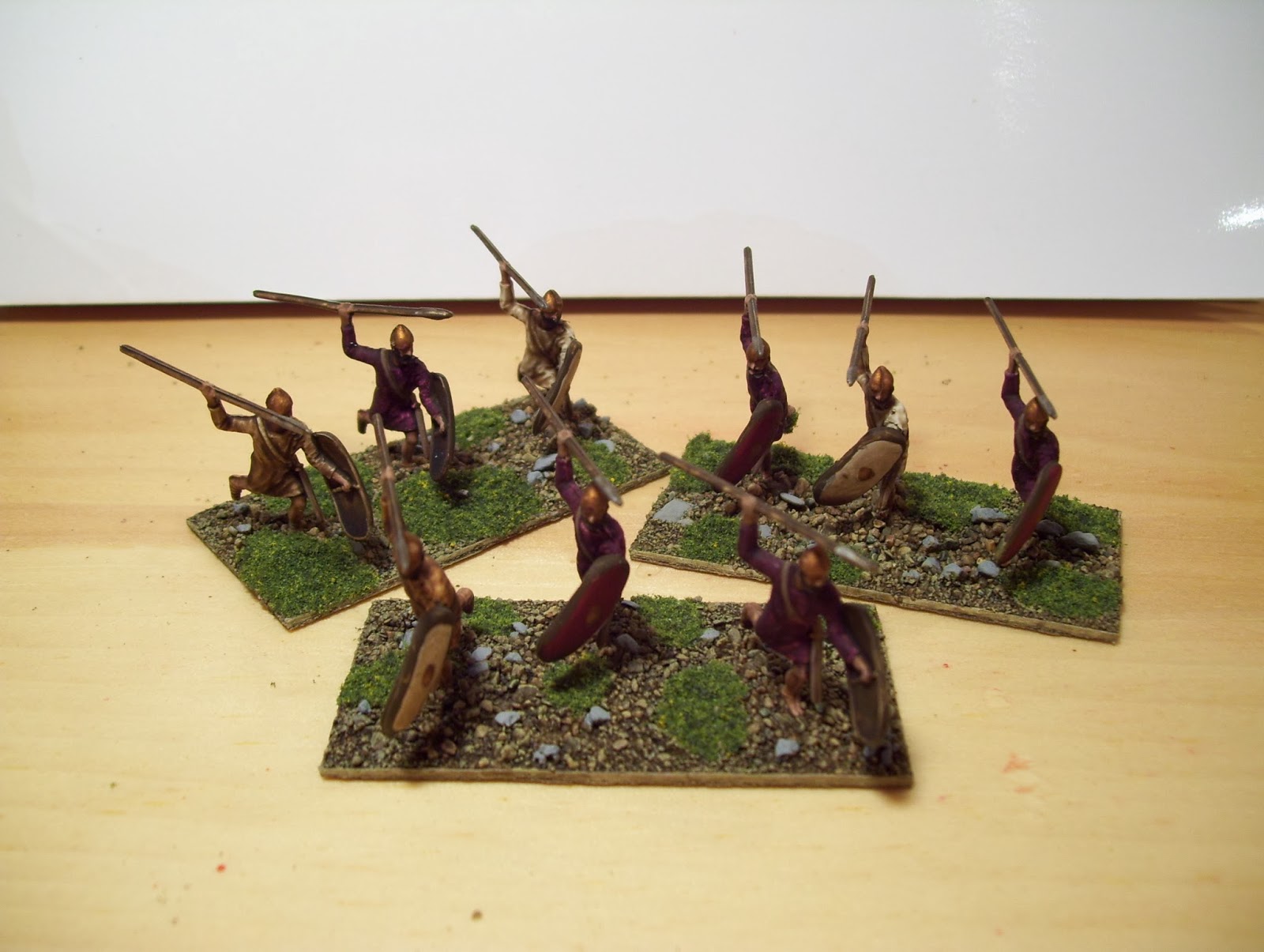hi again!
It seems that I am on fire...I spent every night painting during last week, and I still want to paint some more. So here is last week's result; Cartaginians:
The Camp; Paper tissue on styrene block for the tent. Had a bug with the soldier holding the horse: I had to bend them into shape to get this pose, and, after the paint job, the plastic bent back to it's original shape a little, thus the space between hand and bridle... next time; pose the plastic minis long before painting them...
Cartaginian Cavalry; with the general holding a sword. By the way, I do not like the open hands... it never look like the general is actually holding the sword.
Cartage/libyan spearmen; Hand painted shields, far from award winning, but they look good from 4 feet away! had fun doing those. I saw the design for the shields on the net; not sure where... google image...
Same spearmen, from the other angle.
Same soldiers, this time, as auxiliary. Not sure about that figure choice; see comments below.
Libyan warband. Again not sure about the figure choice. See below.
Numidian elephants; with skirmishing escort...
Numidian light cavalry; very nice miniatures.
Numidian psiloi, again superb miniatures, if we exclude the single weird pose of the guy twisting his shield arm...
Group shoot.
I am very satisfied with these. The colour choice was limited, and gives a unified look, which I like. I got this idea from this guy; who is VERY good with colours...
http://theminiaturespage.com/boards/msg.mv?id=324714
There are a few difficult choices when it came down to figures; specifically the warband and the auxiliary. As I am building armies for many major players of the punic wars, to use in a campaign, I did not want to include allies into the national armies... that meant no gauls nor spanish miniatures in the Cartaginian army. I then used some figures identified as libyan spearmen with a very dynamic and agressive pose to make my warbands, and I used three guys in lose formation to represent auxiliaries...
hope you like it!
next in line:
Spanish!










Very nicely done. And the scratchbuilt tent is cleverly constructed.
ReplyDeleteHey! I'm that guy from TMP ;o) thank you so much for the plug! and you are most welcome...
ReplyDeleteGreat painting and lovely basing and yes your Tent as well, looking forward to your Spanish...
How do you keep/secure the paint on plastic miniatures?
cheers,
Phil
I use Krylon fusion as an undercoat. This paint stick really well to the soft plastic used by 1/72 manufaturers. It is super glossy and does not have much tooth (rugosity on which acrylic paint adhere), but at least it does not chip.
DeleteI then paint basecoat, shading and some highlights. On the romans and the gauls, I simply sprayed mat varnish; but It seems that this is not enough, as some thin parts are now chipping (axe handles, swords, plumes on helmet...) So, on my last few romans, and all my cartaginians, I finished the job with the army painter DIP. it provides a very hard varnish, as well as a great smooth shading.
thanks everyone for your nice comments!
Thanks for the info Jo, I think thats your name Jo? :o) anyway.. it sounds like the key factor to secure the paint on the figures is the sealer, a sealer that can hold the paint without flaking/cracking...hmm..I will check out at my local hadeware store...
ReplyDeleteanyway..I'm checking out some ebay - Zvezda boxes i.e Republican Rome Calalry/Auxiliary Infantry etc. not bad a little high on some prices though...
It has been long time painting plastic miniatures and I would like to have a go painting 1/72 figures during this year. I have been following the Plastic Soldier Review website for a while now and its a great site.
regards,
Phil
Yep, my name is indeed, Jo; Jonathan.
ReplyDeleteDon't neglect the importance of your primer. It cannot do the job alone, but it can certainly ruin it. I experienced flaking of the primer even during painting before I started to use Krylon fusion.
The good points of 1/72 miniatures are, in my opinion, the ultra low price, availability and the realistic proportions.
The bad points are, again in my opinion, the diversity of the available models and the $%?&* material that makes removal of mold lines nearly impossible. I really don't mind working with that plastic for conversions; it is super soft, so can easily bend... but the mold lines... Urrgh...
I will make some attempts to remove those with a soldering iron very soon... I'll make a post about that.
Absolutly excellent, love this work, and the basement is wonderful too!
ReplyDelete